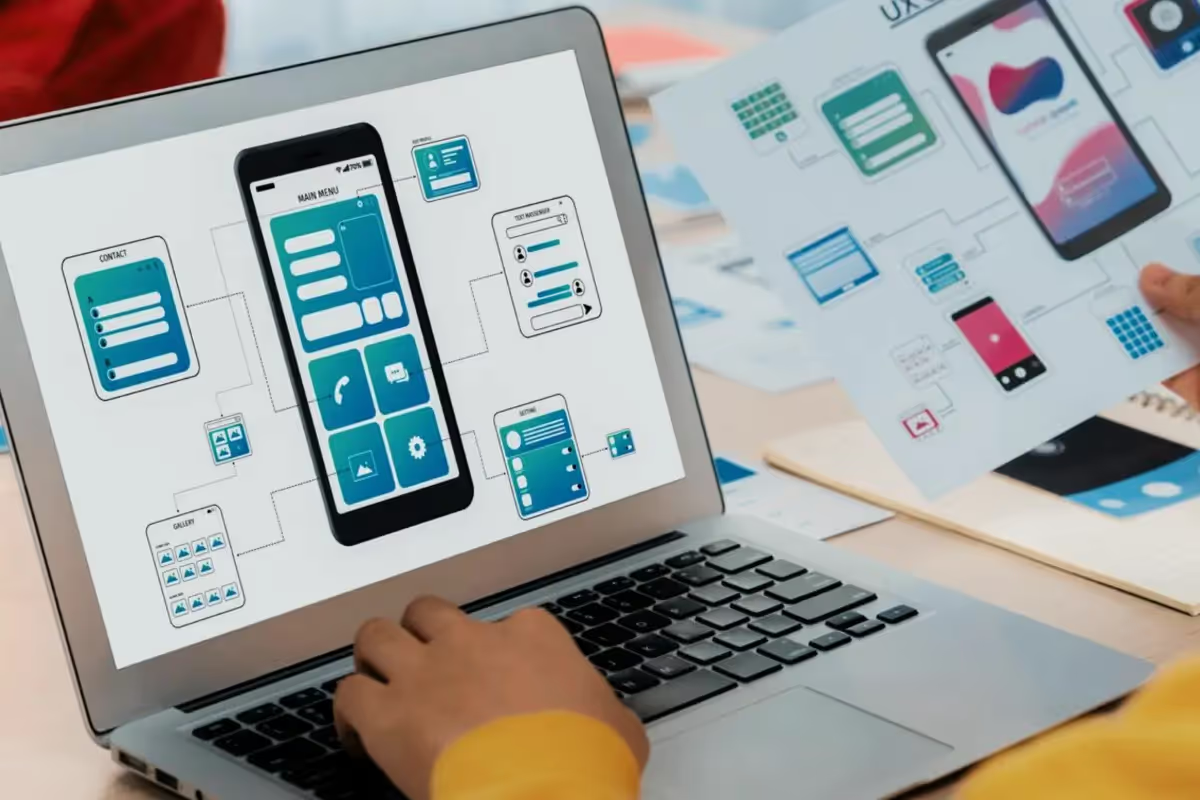People make a lot of online purchases. Sneakers, sunglasses, drugs, office tables — you know, things. Lockdown times sparked an already growing eCommerce app development boom. Making purchases through eCommerce apps became the most convenient and a preferred shopping avenue.
Capital One research forecasts that in 2027, mobile eCommerce sales will surpass $7.08 trillion. With these numbers in mind, you probably start to think of entering the eCommerce market. Or if you’re already there, you might be seeking to attract new customers and increase revenue. The answer is pretty straightforward – developing an eCommerce app.
In this article, I'll round up several steps to building an eCommerce app like Amazon, highlight eCommerce trends, unveil the approximate cost of mobile commerce app development, and list the features your ecommerce app should have.
.png)
What Is Mobile Commerce App?
Electronic commerce was introduced about 40 years ago in its earliest form by English entrepreneur Michael Aldrich. Though his idea didn’t find much support back then, later it became an inevitable part of our lives.
By eCommerce, we mean trading of commercial goods on online marketplaces.. To buy specific items and goods, you simply need to make electronic transactions through your smartphone or computer.
Ecommerce industry grew even further, driven by tech development, globalization, people’s desire for wide choice and better experience.
Today's eCommerce market requires transformation from brick-and-mortar stores into an online presence. And this is where eCommerce mobile app development comes in.
eCommerce Apps Examples That Rock
From personalization to creating a great user experience, here are a couple of eCommerce apps that are nothing short of impressive.
Goat app
I'm a sneaker fan, and I love browsing for shoes. I won’t settle for simple mass-market shoes, so I always look for something unique. Goat app helps a lot in this sneakers’ chase.What I like the most about the Goat app is – search and filter feature. Filters are usually a weak spot for eCommerce apps, but not here. It's so simple, intuitive, and easy to use that I would say it's the best one I've seen in this domain.
Check our our case on developing GOAT

IHerb app
iHerb mobile eCommerce app did a great job by displaying goods' cards in the catalog and PDP (Product Detail Page) layout. This is a real challenge in the pharma field, as all information is different for each category: supplements, sports goods, baby care, etc. — and you still have to remain consistent and follow the same rules in UX, which iHerb did pretty well.

Good apps are successful for various reasons. But the key to failure apps is single – falling short of user expectations. How often have you got lost in an app that you’ve just downloaded? I bet often. From the production perspective it all comes from bad feature prioritization and lack of user testing.
Reasons to Develop an eCommerce App
Ecommerce apps’ market is huge.. But if you still doubt if you need to develop an ecommerce app, here are 3 reasons for you.

World of Smartphones
Right now, there are around 4 billion active smartphones in the world.Most people complete online purchases 24/7 through mobile devices with just one tap. Do you need a more compelling reason to build a mobile commerce app?
Revenue Growth
Smartphones are more than a piece of high-tech circuitry of electronic components. Many worldwide eCommerce apps like Walmart and Amazon have proved that mobile apps attract new customers and increase revenue growth across all devices.

User Behaviour Changes After Covid-19
COVID-19 accelerated the eCommerce boom significantly and had a great impact on the way people buy goods. Total eCommerce spending in May 2020 reached $82.5 billion — a 77% increase from 2019. It would have taken 4 to 6 years to get that number looking at traditional year-over-year increases.
What’s more, there are some reasons to develop eCommerce app than just to have a good adaptive web-view like:
- Fast access to a user;
- Possibility to reach out to users via push notifications;
- Better options to track users' behavior;
- Collect analytics effectively;
- Test hypothesis and new features fast.
eCommerce App Development Trends
eCommerce mobile apps have replaced the traditional way of buying goods. However, it does not mean, that online experience should be different from in-person shopping. Let's figure out what this means and how eCommerce trends create better customer experience.
Big Data
Big data algorithms have become more valuable for eCommerce app development as the number of users in this industry is rapidly growing. For instance, Amazon can predict what you want to buy next and recommend products that you might like. This gives rise to questions like "How did Amazon know what I like? "
Well, these days it is hardly a secret that Amazon tracks users’ actions on the app and uses a big data algorithm to make relevant recommendations.
AR Experience
Augmented reality is what bridges eCommerce shopping with in-store experience. Ikea commerce app is among the retailers who succeed in AR experience the most. Customers of the home furnishings giant get access to the full catalog of goods in AR mode.
One-click Purchase
The convenience of applications of eCommerce is in single-click payments. One payment transaction is both a trend and a must for eCommerce mobile app development. While working on the Dollar Shave Club app, we at Uptech put this feature on top priority.
Since users don't have to retype payment information every time they make a purchase, one-click payments encourage shoppers to complete multiple purchases. It's a great example of how a user-centric approach leads to a better buying experience and business revenue.

AI Chatbots
AI Chatbots help your business be in touch with your users while not pressuring them with an abundance of information. Besides, with AI, you can train chatbots specifically on your business cases, so you can offer users a highly-personalized experience that encourages them to stay loyal to your brand and increases retention.
Social Media Commerce
The trend of social commerce is gaining popularity among e-commerce companies these days. Again, personalized user experience plays the prior role here. Companies integrate their online products into social media platforms (like Facebook or Instagram), allowing users to purchase products while browsing the app. Social commerce will enable users to instantly track price moves and buy products right in that minute.
8 Steps of How to Build eCommerce App
Before moving any further, let me give you a detailed glimpse of the key 8 steps to take while eCommerce mobile app development.

Step 1. Research
We at Uptech are product geeks. That's why we put the research stage on top. We conduct competitors' research and user interviews, which are essential for analyzing the target audience's behavior and patterns. It also helps define the right app platform and the feature set as relatable as possible for our target audience.
Step 2. Set the goals
The foundation of an eCommerce mobile app development lies in setting the goals for your business. Here’re 3 questions that help you set your goals:
- What problems am I trying to solve?
- Who am I selling the product to?
- How do I understand if it's successful?
Step 3. Choose the right platform
I advise you to get to know the ins and outs of your business before deciding what technology to use for eCommerce application development. Keep an eye on the development cost, inventory, and select the CMS, database, and a scalable framework.
With this information at your hands, it's much easier to decide whether you want to launch an Android app, an iOS app, or both. It goes without saying that you need to target the mobile platform where your target audience is on.
Tech stack is a critical condition to turn a brilliant idea into a successful product. By tech stack we mean a complex of components, like:
- Frontend (interface of the app);
- Back-end (processing on the server);
- Development (platform with libraries and interfaces);
- Supporting (technologies that provide app’s security and performance).
For example, when building an Android ecommerce app, you need to think of:
- Programming Language (Java/Kotlin for Android);
- App development tools (Android Studio);
- UI Framework (Jetpack Compose);
- Android UI.
Samely, when it comes to iOS, think of the following:
- Programming Language (Objective-C or Swift);
- IOS Mobile Development Tools (XCode, AppCode);
- UI Frameworks (UIKIt or SwiftUI).
For cross-platform apps the list of programming tools goes like this:
- React Native (JS);
- Flutter (Dart)
- Xamarin (C#).
For more information about the tech stack, read our Definitive Overview On Mobile App Technology Stack.
.png)
Step 4. Define feature set
Since you already have users' feedback, expert opinions, trends, and the itch to outdo your competitors, you now understand better what problems your product needs to solve and which features can satisfy the end users.
To help you decide which product feature takes the top spot on the list, you may use popular prioritization frameworks and strategies.
Step 5. Create UX&UI design
As I mentioned above, the experience in eCommerce apps must go beyond in-person shopping, and UX&UI design is the opportunity to stand out. Design is going to be your voice and business' identity for the target customers. Color schemes, appealing visuals, and smooth transitions from one page to another are what make a lasting impression on your customer.
For more inspiration, check out our design ideas for different on-demand apps on Dribbble:
Step 6. Build MVP
Remember I told you about the product features that should take top priority? MVP stage is precisely where you need to focus on the most vital features of your eCommerce app. Instead of implementing a full-fledged product right away, I advise going for a continuous evaluation of the product, which fuels further revisions.
MVP aims to learn what users think of the product, cut development time, reduce risks, and allocate resources more efficiently.

Step 7. Gather feedback
When the MVP is released, it's time to start gathering feedback from customers. It's a process of checking how users interact with your app, capturing feedback, and finding possible improvements. Feedback collection is significant in ecommerce app development as it helps you figure out what works for your target audience and what doesn’t.
Step 8. Iterate
Last but not least, iterating. If we look at the biggest players in the eCommerce app market, we can see that design is never constant. Instead, it's constantly evolving and adapting to market/user needs.
eCommerce App MVP Features
First of all, I'd like to highlight the meaning of MVP. Minimum Viable Product is the bare form of the product that is capable of solving the user's problem.
"If there is a nice-to-have feature you hesitate about, then you probably should not include it in MVP."
People don't need more filters when looking for something online — they need better results. It follows that the must-have features depend on the product itself. If you are building Shazam, you will need only one button to test the idea. If you are making the next Amazon, you will need only those features that provide maximum value to your customers.

We've seen many products fail because they were too slow to ship and very few because they were too quick. Better to release something small first, gather feedback, let people tell you what features make sense, and implement changes.
3 Things to Consider Before Developing a Mobile eCommerce App
There are always restrictions in the app development process that need special attention. Ecommerce app development is no different. Here are the moments to consider when developing an eCommerce app:
Data Security
When users sign in to your eCommerce mobile app, the first thing they do is give you their personal information: home address, credit card number, number of their mobile phone, etc. Well, your users trust you, and that’s good news. But you cannot disappoint your customers, so take measures to protect their personal information from unauthorized usage. To do that, you can take the following steps:
- Use a private cloud. If you store user information in a digital cloud, you should make sure your provider delivers a personal cloud regime;
- Define access rules. For example, only premium subscription users have access to certain services.
- Alarm system. Even in an emergency, you are quickly informed of the threat and can act quickly to minimize the negative consequences.
Scalability
Your app needs to be scalable to handle an ever-growing number of users. It can seem that you should not think of the app’s scalability at the outset of eCommerce mobile app development. But the truth is that you need to forecast the growth of your app at the beginning of the development and plan your app’s architecture, respectively.
Stability
Instability and constant crashes are other elements that can significantly lower your app’s performance. Well, users would not prefer to stay with an inconsistent and poorly balanced app. To reach stability in your app’s performance, you should:
- Run QA tests;
- Make several product iterations;
- Get feedback from users;
- Release fixed updates.
How Much Does It Cost to Create an eCommerce App?
Finally, we reached the final part – the cost of eCommerce app development. It’s a vital stage for any entrepreneur since you need to estimate the budget, plan the expenses and figure out whether the game is worth the candle. As for mobile eCommerce app development costs, it is rather complicated to provide you with accurate prices.
First, everything depends on the goals and requirements. For example, on the number of features, mobile platforms, UI/UX design complexity, etc.
Second, the cost is different depending on the location where a software development company is located. For comparison, the hourly rates of App Designer in the USA and Canada start from $150, while in Western Europe, rates may be from $50 to $100. Eastern Europe provides the most optimal rates, from $35 - $60.

That is why eCommerce application development may cost you either $80K or $150K and even more. It’s hard to predict the initial cost in advance. If you need precise numbers, feel free to drop us a line on your eCommerce app idea and product demands. We will provide you with detailed information.
Final Word
To make a long story short, today's eCommerce app development business is experiencing a boom for several reasons: significant usage of smartphones, pandemia, consumers’ desire to seek new, and other global circumstances.
Having an eCommerce app creates many opportunities for your business, from fast access to users to a competitive advantage. We also looked at top players in the eCommerce industry, and now you have some trends to follow. But the bottom line in the overall eCommerce app development process is focusing on the customer and finding the best user-oriented solution.
If you're about to make an eCommerce app and looking for product support, tell us about your product and we'll contact you. With 7+ years of experience under our belt, we know how to create a custom-made solution that works for your audience and product.























































































.avif)












